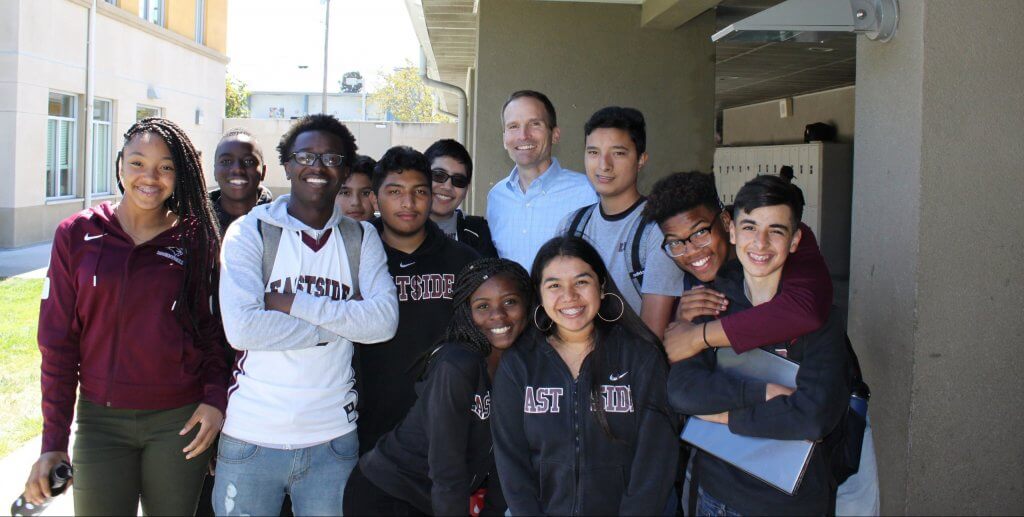Big Topic on Campus: Doing Well by Doing Good
Dr. Paul Farmer speaks with a patient at University Hospital in Mirebalais, Haiti
Photo: Rebecca E Rollins, Partners in Health
Once upon a time, the visiting “rock stars” on college campuses were, well, rock stars. Or at any rate they were people who exuded rock-star glamour—luminaries from the world of entertainment and celebrity, or high-profile figures from “power” fields such as government, law, and business.
It’s different now. Today, the speakers who draw the biggest and most boisterous crowds—who fill students with a yearning to follow in their footsteps—are often dedicated men and women who run “do-gooding” organizations. They are nonprofit leaders and social entrepreneurs. In many cases, they work in the poorest, least-glamorous regions of the world.
Consider the unlikely stardom of Dr. Paul Farmer. He’s a co-founder of Partners in Health, a highly regarded nonprofit that brings health care to the world’s poorest families in countries such as Haiti and Peru. He was the featured subject of the bestselling book Mountains Beyond Mountains, by Tracy Kidder. A few years ago, he came to Stanford University, where both of us now teach. We were simply astounded by the reception that he got.
Farmer spoke to a standing-only crowd of students who listened rapturously to his every word. These students wanted to see him, to hear him, to learn from him. They wanted to be him. Many of them clearly viewed his career as an agent of social change as a compelling model for their own nascent careers. Bill Drayton of Ashoka, Jacqueline Novogratz of Acumen, Raj Panjabi of Last Mile Health, and Fred Swaniker of African Leadership Academy also draw crowds on campuses across the United States and around the world.
Hard data, meanwhile, show that this shift in students’ interest is both real and deep. It goes beyond the momentary excitement of a speaker’s appearance on campus, and it involves pivotal career choices. Consider Teach for America (TFA), a nonprofit that recruits and trains college graduates to teach in low-income U.S. K-12 schools. According to a recent report, TFA has become the top employer among new graduates from a set of 40-plus leading colleges. In one recent year, 12% of all graduating seniors from Ivy League universities applied to join the organization.
To be sure, plenty of Ivy League grads still go into law, finance, and other lucrative fields. But the rise of TFA as a desirable career step for students at elite universities points to a sea change in how young people regard social sector work.
The advance of scholarship
This growing enthusiasm for the social sector doesn’t apply only to students. The faculty members and administrators who direct scholarly attention and institutional resources to favored disciplines have given their blessing to this field as well. Today, more than 300 universities offer programs that focus on the study of nonprofits and foundations. Institutions that offer leading programs in this area include the Indiana University Lilly Family School of Philanthropy, the Program on Social Enterprise at the Yale School of Management, the Skoll Center for Social Entrepreneurship at Oxford University’s Said Business School, the University of Pennsylvania’s School of Social Policy & Practice, the Social Enterprise Initiative at Harvard Business School, the Center for Social Entrepreneurship at Duke Fuqua School of Business, the Stanford University Center for Philanthropy and Civil Society, and the Drucker School of Management at Claremont Graduate University.
Last week, the Academy of Management held its annual conference in Chicago, which drew an attendance of more than 10,000 management scholars. For those who study business and organizational leadership, the AOM gathering is one of the foremost events on the academic calendar. At this year’s conference, we noticed that alongside the expected sessions on topics such as corporate strategy and human resources management, there was an especially robust programming track for scholars who focus on nonprofits and philanthropy. (The Association for Research on Nonprofit Organizations and Voluntary Action, known as ARNOVA, continues to flourish as well, and we look forward to attending its annual conference in November.)
In our view, these are heartening developments. Our involvement in teaching and research on leading social sector organizations goes back decades. Indeed, Bill started teaching a course on nonprofit leadership at Stanford Graduate School of Business in 1998. At that time, there were very few high-quality case studies about nonprofits, so Bill undertook an ambitious effort to research and write a series of cases on organizations such as Ashoka, GuideStar, and the Oregon Shakespeare Festival. (Visit our website for a list of these case studies, along with links to other resources that we’ve created for educators.) Seeing the wide range of scholarly inquiry about the sector that is on display at an event like the AOM meeting reminds us that the field has come a long way over the past 20 years.
The challenge of teaching
But even as we celebrate this progress, we are left with some nagging questions: How well are we translating the work of scholars who study social sector issues into programs for students who are eager to become the next Paul Farmer? How well are we actually preparing these students to be effective leaders who can achieve substantial impact? Are these students—most of whom are millennials—genuinely willing to spend their life serving others, even when their net worth and their lifestyle suffer by comparison with those of their investment banking friends?
In some instances, we fear, the training that students in this field receive fails to go much beyond inspirational storytelling. Many courses do not provide a substantive basis for maximizing impact or for building organizations that can achieve significant impact at scale. This can be most problematic in courses on social entrepreneurship, which are all the rage with today’s students. Many such courses mislead their enthusiastic students to believe that “every idea is a good idea,” and the path for each is to simply “start-up, then scale up.” Our recent book, Engine of Impact, argues that social entrepreneurs must instead “earn the right to scale,” which requires excellence in seven essentials of strategic leadership.
For many years, we have been on a crusade to bring strategic rigor to the nonprofit sector. In our next post, we will describe our approach to doing so within the context of educating young leaders.
Originally published in Forbes

